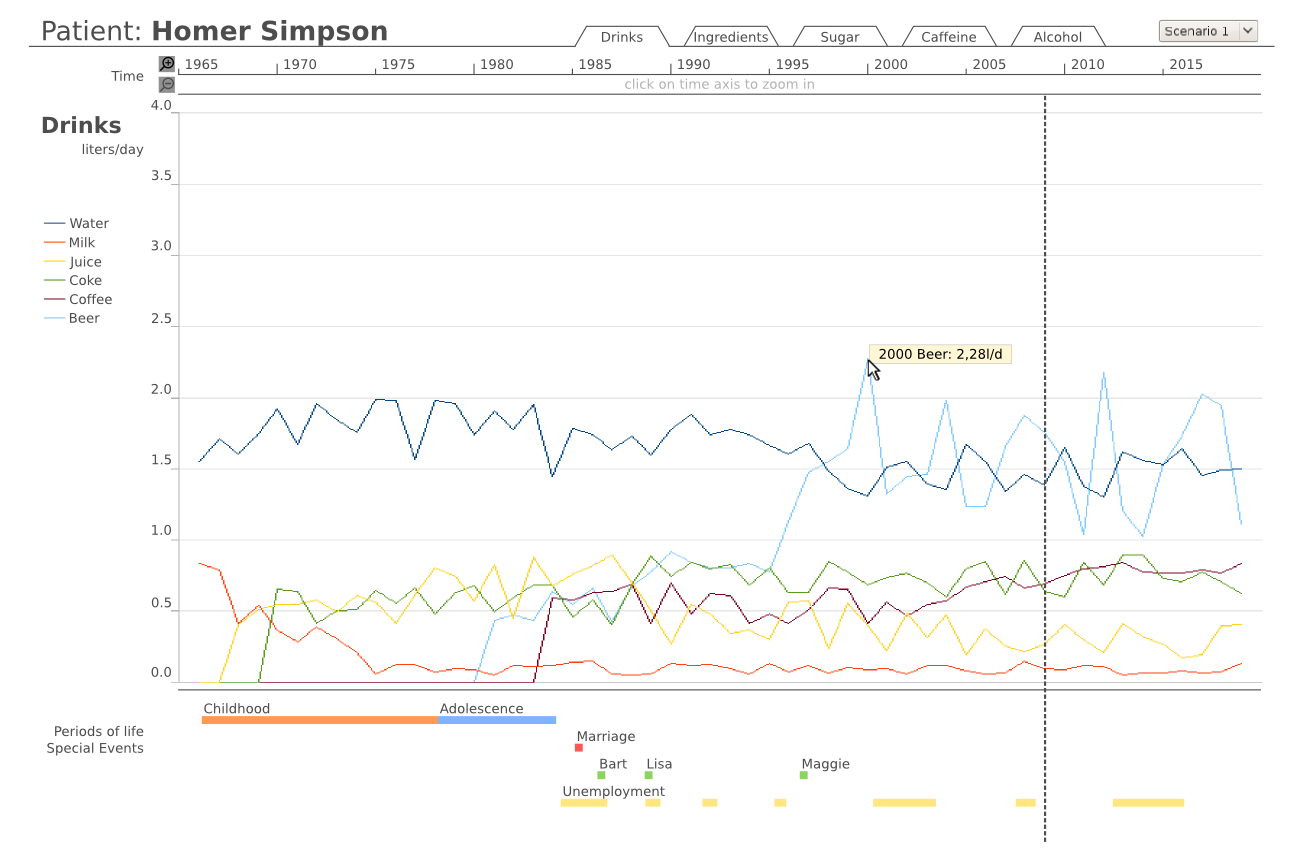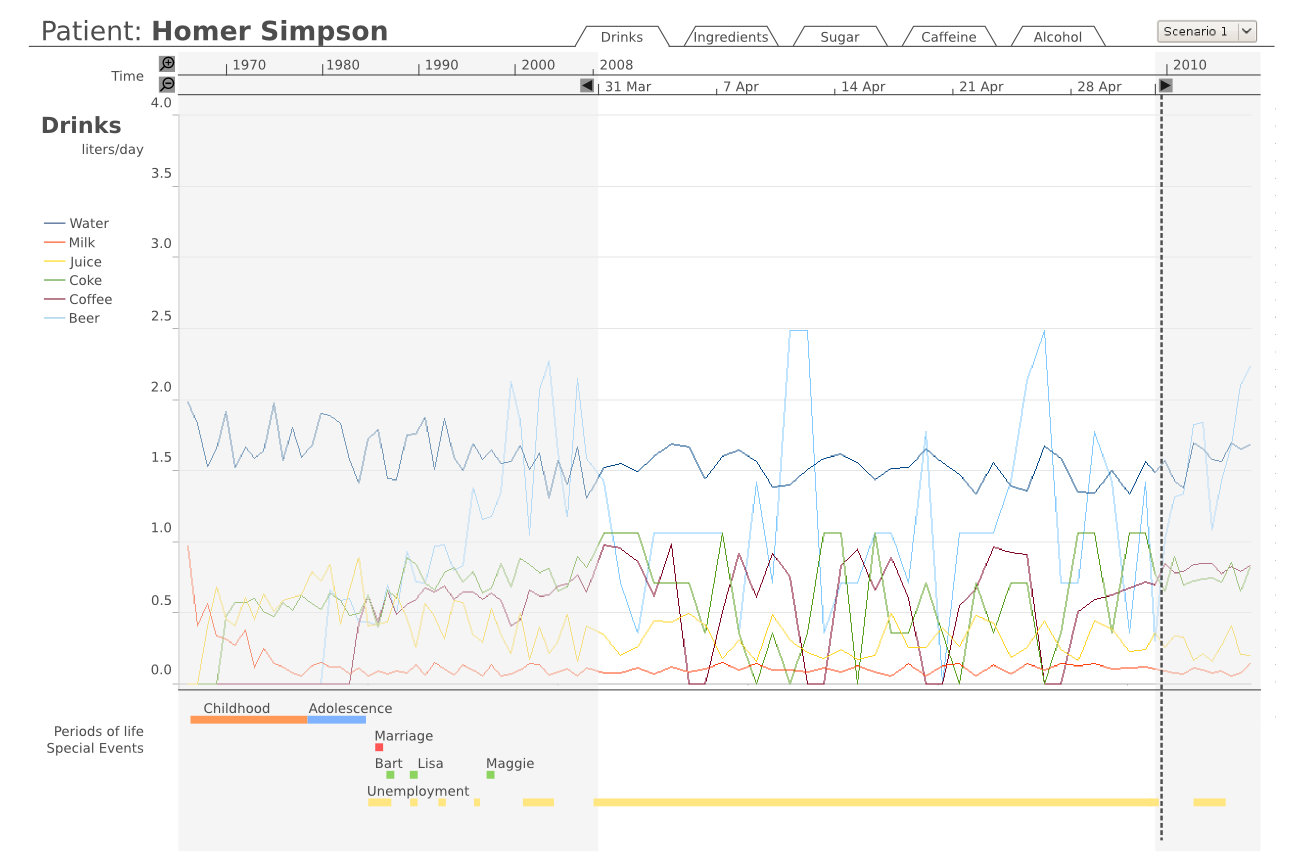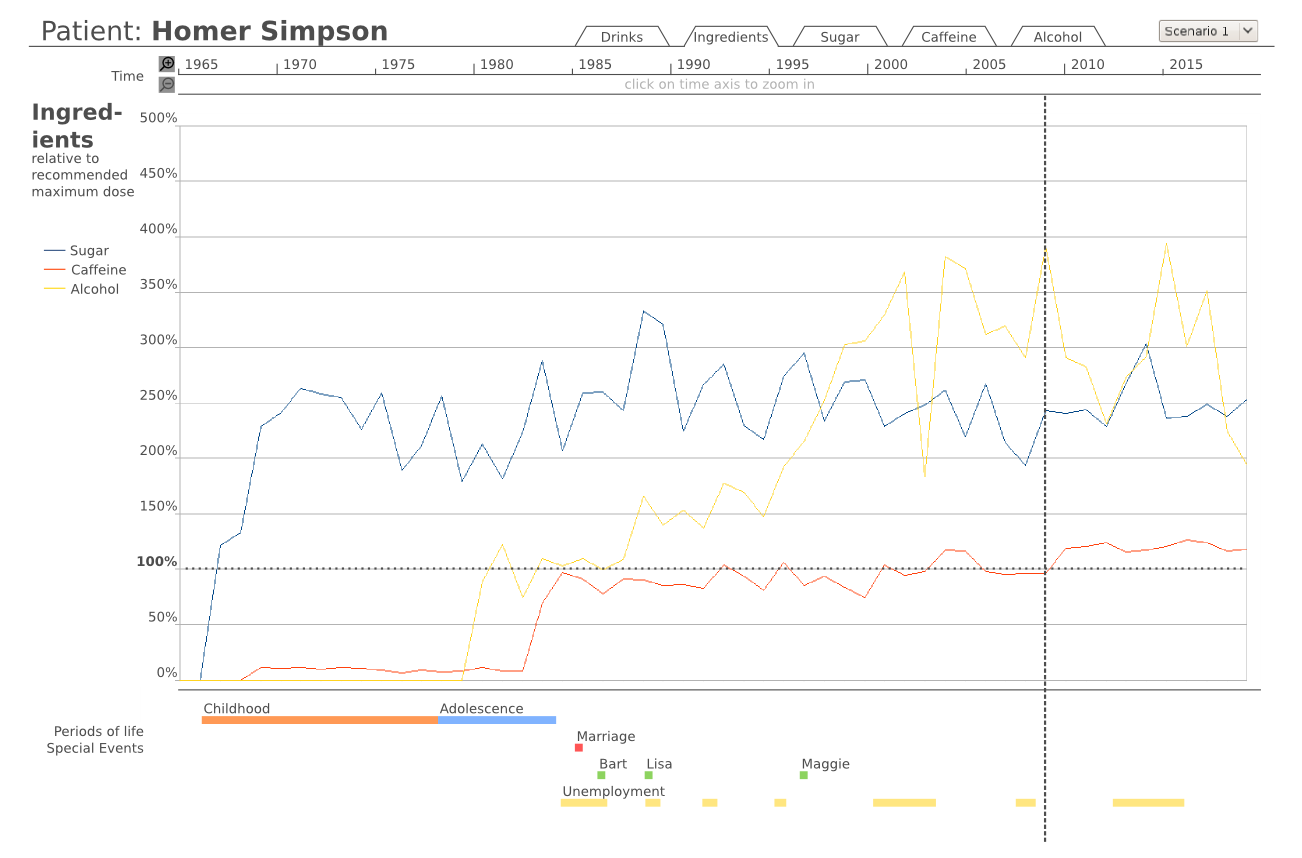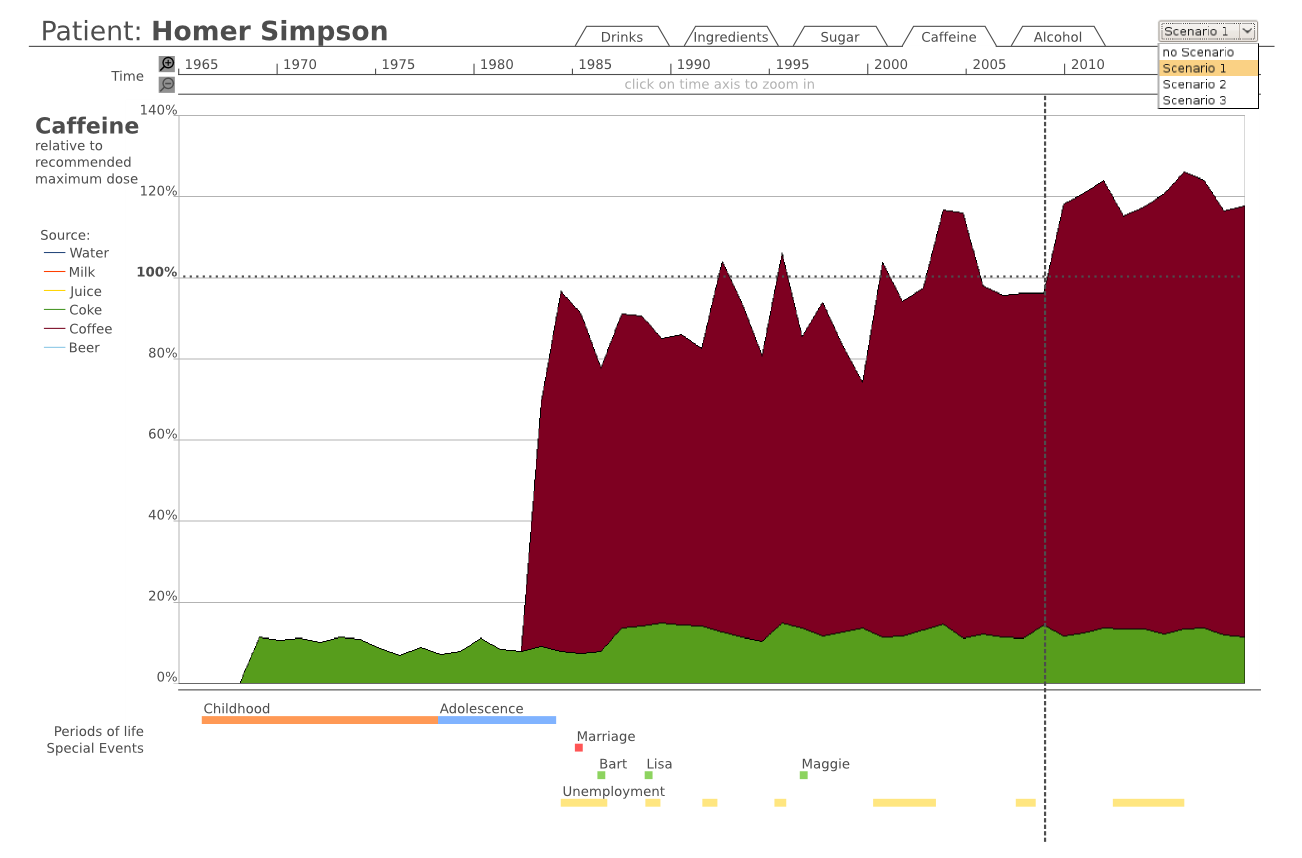Teaching:TUW - UE InfoVis WS 2008/09 - Gruppe 06 - Aufgabe 4
Aufgabenstellung
Gegebene Daten
Homer Simpson's Trinkverhalten in Abhängigkeit von seinen Lebensumständen
...Visualisierung von Homer's Lebensabschnitten bzw. Ereignissen mit Einfluss auf sein
Trinkverhalten (zB.: Kindheit, Pubertät, Arbeitslosigkeit, Beziehungen, Hochzeit, Geburt
der Kinder, Liebeskummer, Alltag, etc.) von seiner Geburt bis Jetzt + mögliche
Zukunftsszenarien (mind. 3).
- Die Menge folgender Getränke soll für die jeweiligen Lebensumstände ablesbar sein
(ml oder Liter - je nachdem - pro Tag, Monat, Jahr (z.B.: Fokus+Kontext Methoden):
a) Wasser
b) Milch
c) Fruchtsaft
d) Cola
e) Kaffee (Würfelzucker?)
f) Bier
(vereinfacht angenommen, Homer trinkt ausschließlich diese Getränke)
- Die folgenden Werte sollen abhängig von den konsumierten Getränken ablesbar sein:
1) g oder kg konsumierter Zucker (aus Getränken) + empfohlene Maximaldosis pro Tag, Monat, Jahr (empfohlene Maximaldosis/Tag: 50g; enthaltener Zucker: 10g/100 ml Cola; 10g/100 ml Fruchtsaft; 3g/Würfelzucker).
2) mg konsumiertes Coffein + empfohlene Maximaldosis pro Tag, Monat, Jahr (empfohlene Maximaldosis/Tag: 600mg; enthaltenes Coffein: 10 mg/100 ml Cola; 80 mg/100 ml Kaffee).
3) g konsumierter Alkohol + empfohlene Maximaldosis pro Tag, Monat, Jahr (empfohlene Maximaldosis/Tag: 20g; enthaltener Alkohol: 3,6 g/100ml Bier)
- Die Daten sollen zur medizinischen/psychologischen Analyse visualisiert werden.
- Die bisher erlernten Design-Prinzipien sollen umgesetzt werden (z.B.: Optimierung der Data-ink ratio).
- Die Mockups sollten zumindest 1) Homer's Leben im Überblick 2) und eine Detailansicht wiedergeben.
- Alle nicht angeführten Daten können frei erfunden werden.
Links
General description and background
Field of application
The visualization will be used by experts for medical and psychological analysis. The visualization shall provide information of a single patient, and give details about their consumption of several different drinks (water, milk, juice, coke, coffee, and beer), and the thus resulting consumption of sugar, caffeine and alcohol. It shall be possible to visualize both a time-line overview of these consumptions, as well as detailed views for specific periods in time. Additionally, certain periods of life, such as childhood or puberty, and specific events and happenings such as unemployment, wedding(s), or birth of the children, shall be indicated.
Analysis of the data set
The application displays abstract, multi-dimensional, time-oriented information:
- Drinks: Consumption of six different drinks (water, milk, juice, coke, coffee, and beer) and sugar cubes by day.
- These dimensions have a continuous data type.
- Ingredients: The amount of dangerous substances (sugar, caffeine, and alcohol) contained in the drinks and in the lump sugar.
- These dimensions have a continuous data type.
- These variables are derived from the drinks and sugar cubes.
- Events: Certain periods of life and specific events (e.g., childhood, unemployment).
- This dimension is of a nominal data type; they can be distinguished, but they cannot be ordered, as they might be overlapping.
The following table gives a detailed overview on each datum:
| Dimension | Data type | Unit |
|---|---|---|
| water | continuous | ml |
| milk | continuous | ml |
| juice | continuous | ml |
| coke | continuous | ml |
| coffee | continuous | ml |
| beer | continuous | ml |
| lump sugar | discrete | pieces |
| sugar | continuous | g |
| caffeine | continuous | g |
| alcohol | continuous | g |
| events | nominal |
Temporal Dimension
We can characterize the temporal dimension as follows [Aigner, 2006, pp. 13-17]:
- The application's time domain is branching, because it allows the description of alternative scenarios.
- The time scale is discrete and days are the smallest granularity used.
- Drinks and ingredients are totally ordered, whereas events are partially ordered, because they might be overlapping.
- The temporal primitives used for drinks and ingredients are instants, whereas intervals are used for events.
- The application uses the Gregorian calendar and different temporal granularities like months and year will be made available to the users.
Details and Examples
The ingredients of the drinks, and their recommended maximum dose per day, are as follows:
| Sugar | Caffeine | Alcohol | |
|---|---|---|---|
| Water | |||
| Milk | |||
| Juice (100ml) | 10g | ||
| Coffee (100ml) | 80mg | ||
| Lump sugar (per piece) | 3g | ||
| Coke (100ml) | 10g | 10mg | |
| Beer (100ml) | 3.6g | ||
| Daily dose | 50g | 600mg | 20g |
For the events and periods in life, the data would look like:
| Start | End | Type | remarks |
|---|---|---|---|
| 13.4.1965 | 12.4.1972 | Childhood | |
| 7.7.1977 | 7.7.1977 | Wedding | |
| 25.7.1980 | 25.7.1980 | Birth | Bart |
| 1.8.1981 | 31.10.1982 | Unemployment | |
| 12.10.1982 | 12.10.1982 | Birth | Lisa |
An exemplary data set for the consumption would look as follows:
| Date | Water | Milk | Juice | Coffee | Lump sugar | Coke | Beer |
|---|---|---|---|---|---|---|---|
| 7.7. 1977 | 0.25 | 0.5 | 0 | 0.75 | 5 | 1 | 5.5 |
| 25.7. 1980 | 0 | 0 | 0.25 | 1.25 | 12 | 0 | 0 |
| 1.1. 1993 | 1.0 | 0 | 0.25 | 0.25 | 2 | 0.33 | 1.5 |
Analysis of the target group
The intended target group of the visualization are physicians, psychologists and nutritionist. Thanks to their education they can interpret of the data and thus do primary need hints what different values imply but require guidance to navigate through the data and conceive it.
On the other hand it cannot be assumed that the users have technical knowledge of interactive systems or are willing to acquire it, therefore the visualization must be intuitive and as far as possible self descriptive.
Furthermore possible limitations by the target hardware must be taken into account. This could also limit the possibilities of interaction (e.g. screen-size, no keyboard or no mouse but a touch-pad).
Goals of the visualization
The visualisation shall allow medical doctors to get a fast overview on excess consumption of certain drinks and the thus resulting consumption of substances, potentially to be able to link it with certain symptoms and diseases Homer might suffer from.
For psychologists, it might be more relevant to link the consumption to events, to find patterns in what circumstances Homer tends to have an excess consumption of the certain drinks. It might be especially interesting to spot excess consumption that cannot be linked with a certain event, for example too much beer consumption that isn't in relation to a celebration or a known phase of depression, like unemployment.
Generally, we assume the doctors to use these tools mainly during a physical examination, or maybe a ward round; we thus expect the doctors having a limited amount of time available for inspecting the data, thus they should be able to get a fast overview and fast zooming into specific time periods. Therefore, we want to provide for a simple navigation, and rather focus on displaying data in the context of the whole life span, rather than giving (too) detailed data or even numbers for a specific date.
Concept
Visualization
Type of Visualization
Kosara and Miksch [2002] describe three types of applications for Information Visualization in medicine: visualizing measurements, displaying incidents, and planing the future. This application requires the visualization of quantitative values and events. Therefore it combines charts with a LifeLines inspired view of events [Plaisant et al., 1998].
The quantitative data set is composed of multiple instances of several measures taken periodically, i.e. a time series, which is best visualised as a line chart [Few, 2004]. We have several different aspects to visualize
- Consumption of drinks
- Consumption of substances/ingredients
- Individual consumption of caffeine, sugar and alcohol, indicating the source of the substance
The first two can be visualized with normal line charts, while for the last one, we opted for a stacked line chart.
Visual Mapping
For the quantitative data set the visual mapping is the same in all our visualisation variants, and rather simple: the time series is mapped to the horizontal axis [Few, 2004], while the vertical axis maps the values at the specific point in time. The scale of the vertical axis either measured in litres consumption per day, or as a percentage of the recommended daily dose. The recommended dose, which is at 100%, is specifically highlighted, to allow for easily spotting over-consumption.
For events, the instances are mapped to horizontal bars, which extend from their start date to their end date. For very short time interval (e.g., birth of Barth) the bar made wider, so that the event is visible.
Techniques
The application uses the following visualization techniques:
- Line charts for time-series [Few, 2004a]
- LifeLines [Plaisant et al., 1998]
- Focus and context [Leung and Apperley, 1994]
Mockup(s)
The imaginary data-set and the charts were produced using Open Office Calc, while the final mockups were created with a drawing-program.

Figure 1: Overview and standard visualisation, showing the consumption of drinks during the whole life of the patient.

Figure 2: Detailed view of a specific period of time, using the focus and context technique.
It is possible to observe weekly patterns in consumption of beer and coffee.

Figure 3: Overview, showing the consumption of substances.

Figure 4: Overview, showing the sources of caffeine consumed.
Interaction
As the application is meant for medical doctors and psychologists, we kept the interface simple. We want to avoid situations, where the users might get lost in a specific view / selection and not find their way back.
Still, we provide the following interaction modes:
- Switching between different data to visualise: with the tabs on the top-right part of the tool, just above the time-line. This allows the user to select either the consumption of drinks, consumption of substances, or detailed consumption and sources for each of the substances caffeine, sugar and alcohol.
- The visualizations in all tabs are connected with each other: If the user zooms in a tab and then changes to another tab, the same timespan will be focussed.
- Zooming into a specific period of life: this can be initiated by clicking on a specific location of the time-line, and by using the (+) and (-) buttons. Zooming uses the "focus and context" technique to always view the selected area in context with the data of the other stages of life of the patient [Leung and Apperley, 1994].
- The user can zoom in and zoom out by clicking on the (+) and (-) buttons.
- Panning is possible by clicking on the < and > buttons.
- By clicking on a LifeLine bar, the user can move the focus of the visualisation on that time span.
- Details on demand
- If the user moves the mouse pointer over a line, a small popup will show the value at this point of time (Figure 1).
- Moving the mouse over a LifeLine bar, the exact start and end date will be shown in a popup window.
- Switching future scenarios: By selecting one of the options from the drop-down box on the top-right, the user can select one of the future scenarios (Figure 4).
- A vertical dashed line separates past data from estimated future values.
Discussion
Our tool supports users by presenting relevant data at a glance. Charts showing important quantitative data are shown in alignment a view of the patient's social environment, which helps to identify events and periods with significant impact on the patients health.
The screen setup is kept simple, thus focusing the user's attention to the relevant data.
While focusing on data relevant for physicians most charts do also have a meaning for patients. Especially charts rising significantly over the 100%-limit emphasize the need for a diet change.
Advantages and drawbacks
- Our tool is simple, and clear in presentation, with only showing one chart per screen.
- We focus on showing only the most relevant visualisations of the data, while skipping e.g. summary charts for a specific period, or displaying numerical data. This reduces the needed interaction and number of available system states significantly.
- However, showing more charts per screen would allow the users to visualize several aspects of the data at once, and maybe get some insights that might be more difficult to achieve otherwise. However, clarity and the need for interaction would clearly raise.
Future Work
As future work on this prototype, we should carry out user studies to back up or change some of the design decisions, namely:
- A comparison of the currently employed "tabs" to change the visualized data with displaying all charts on one screen, with the possibility to collapse/expand each of them, should be carried out.
- Additionally, alternative user-interface elements than the tabs, e.g. radio-buttons, might be tested
- An evaluation of the "focus and context" method, possibly comparing it to other zooming techniques.
Further, it might be worth to provide the users with annotation tools, to support documentation of their own insights as well as facilitating communication and discussion on a specific patient with colleagues.
Finally, Visual Analytic methods should be utilised to help the users find patterns in the data.
References
- [Aigner, 2006] Wolfgang Aigner. Visualization of Time and Time-Oriented Information: Challenges and Conceptual Design. Ph.D. thesis, Vienna University of Technology, 2006.
- [Few, 2004] Stephen Few. Show Me the Numbers - Designing Tables and Graphs to Enlighten. Analytics Press, Oakland, CA, 2004.
- [Kosara and Miksch, 2002] Robert Kosara and Silvia Miksch. Visualization Methods for Data Analysis and Planning in Medical Applications. International Journal of Medical Informatics, 68(1-3):141-153, December 2002.
- [Leung and Apperley, 1994] Y.K. Leung and M.D. Apperley. A Review and Taxonomy of Distortion-Oriented Presentation Techniques. ACM Transactions on Computer-Human Interaction (TOCHI), 1(2):126-160, June 1994.
- [Plaisant et al., 1998] Catherine Plaisant, Richard Mushlin, Aaron Snyder, Jia Li, Dan Heller, and Ben Shneiderman. LifeLines: Using Visualization to Enhance Navigation and Analysis of Patient Records. Technical Report HCIL-98-08, University of Maryland, 1998.